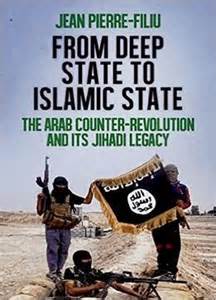|
Reviewed by Z. Asli Elitsoy, Ph.D. Student, Bilkent University, Ankara, Turkey Global jihadist groups like Al Qaeda and the Islamic State are a post-Cold War phenomenon that scholars have examined from various perspectives in an effort to identify the social and ideological conditions leading to the emergence and expansion of such groups. In his comparative historical study, Jean-Pierre Filiu, Professor of Middle East Studies at Sciences Po in Paris, provides a comprehensive analysis of the continuous involvement of military and intelligence agencies in politics in various Middle Eastern and North African countries such as Egypt, Syria, Yemen, and Algeria. Filiu argues that the counter-revolutions organized by the Arab “Deep States” caused the failure of the Arab uprisings, which began in Tunisia in December 2010, to generate a long-term democratic change. Moreover, in order to maintain the status quo, the “security mafias” (as Filiu calls them) contributed to the rise of the jihadist movements. Filiu uses the Turkish concept of “Deep State” to describe a political situation in which civilian authorities, security forces, and organized crime bosses form a shadowy criminal organization within the state to pursue their interests. He argues that until the Arab uprisings of 2011, the concept of the Deep State was irrelevant to the Arab world since the ruling regimes were already dictatorial – both one-party systems of Syria and Iraq, or military-dominated regimes of Egypt and Algeria. In the post-uprisings period, however, the hope for democracy in many of those countries has been smashed by the return of the old ruling clique to power through an anti-democratic counter-revolution. In order to explain how the security apparatuses of the authoritarian Arab regimes were established and empowered in the post-independence years, Filiu draws a parallel between Mamluks soldiers, who ruled Egypt and Syria under the protection of the Abbasid Caliphs until 1517, and the Arab “security mafias.” The difference is that the medieval Mamluks derived their source of legitimacy from the Abbasid Caliphs, who were actually subordinated by the Mamluks, while the modern day Mamluks base their legitimacy upon the claim to popular support. In the following chapters, Filiu provides a historical account of how the ruling military cliques justify and maintain their power over the decades by promoting themselves as the only defenders of the Arab nation against Western imperialists and Zionists. In addition to their claim of being the “true owners” of the nation, the modern day Arab Mamluks also gained control of the vast economic resources and production activities of the state by adopting national policies, like Colonel Houari Boumedienne in Algeria and Gamal Abdel Nasser in Egypt. Thus, their long period in power enabled the Arab ruling military cliques and their protégés to consolidate their strength by establishing patronage networks benefited disproportionately from their monopolization of national resources and smuggling revenues. According to Filiu’s analysis, even the new international conjuncture that has been created as result of the 9/11 attacks on the United States by Al Qaeda has been turned into a benefit for the Arab Mamluks. Their cooperation with the George Bush administration’s “global war on terror” gave them an opportunity for international integrity. In Yemen, for instances, President Ali Abdullah Saleh consolidated his control over the security apparatus through kin and protégés in the name of the war against Al Qaeda in the Arabian Peninsula. Moreover, Filiu argues that the Bashar al Assad regime in Syria used the jihadist threat to stifle criticism of its governing style while the security apparatus conspicuously cooperated with jihadist networks. That is to say, both the Arab Deep States and jihadist networks have been working hand in hand to crush any democratic impulse in the region. Filiu’s historical analysis methodology which permits him to provide a broad picture of how the Arab military elite has gained confidence in the nation’s political leadership and established their Deep States in the post-independence period, is the strongest part of his book. Although the military elites’ role cannot be overlooked in the radicalization process of jihadists, these movements need to be analyzed in relation to political and social changes in Middle Eastern societies as a whole. Complicated sectarian relations and the Western intervention in Middle East politics need to be included in an analysis as well as the role of religion in Middle Eastern society, culture, and politics. Otherwise, the picture would be incomplete. |


 From Deep State to Islamic State: The Arab Counter-Revolution and Its Jihadi Legacy
From Deep State to Islamic State: The Arab Counter-Revolution and Its Jihadi Legacy